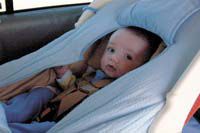| Frankie Sacco settles into his car seat after being safely fastened into a rear facing child restaint device. According to Utah Highway Patrol data, more than one-half of serious injuries and fatalities incurred in auto accidents could be avoided with proper use of safety belts and child safety restraints. |
The Utah Highway Patrol reminds Carbon County residents that state statute requires drivers to buckle up and properly restrain children traveling in motor vehicles.
Child passengers are the responsibility of motorists, according to Utah law, and the the safety of youngsters must come first.
According to the United States National Highway Traffic Safety Administration, deaths and serious injuries caused by motor vehicle crashes could be reduced by approximately 50 percent with proper and consistent use of safety belts and child restraints.
To help increase safety belt use, traffic safety advocates have developed a combined approach involving legislation, public information, public education and law enforcement efforts.
In 1984 Utah adopted legislation requiring children younger than age 5 years old to be restrained while riding in a motor vehicle.
In 1990, an amendment to the statute required children younger than age 2 to ride in child safety seats.
The 1990 amendment also required youngsters ages 2 to 8 to ride in a child safety seat or seatbelt.
Further, in 1986 Utah enacted a law requiring all driver and front seat passengers to buckle up.
The state statutes are reinforced by community programs and promotional campaigns. In addition, law enforcement efforts have helped reduce traffic accident injuries and deaths along Utah highways.
According to the UHP, driving at a responsible speed is also imperative to the safety of child and adult passengers traveling inside motor vehicles.
Utah lowered the maximum speed limit to 55 miles per hour in 1974 to comply with the federal energy program.
A significant benefit was realized with the saving of 133 human lives the first year and the reduction of 2,200 injuries resulting from traffic crashes, according to state officials.
The UHP’s Website reports that, with the increase in speed limits to 65 plus miles per hour, it is estimated that 50 additional lives will be lost on Utah highways each year.
The Utah Highway Safety Office will continue to support law enforcement, safety restraint use and the decrease of impaired of impaired driving in order to help keep the death toll to a minimum.
In 2002, 63,000 children younger than age 4 were involved in automobile crashes.
According to child passenger safety professionals, many of the crashes revealed high levels of misuse of child safety restraint systems.
In the mid-1990s a study conducted for the National Highway Traffic Safety Administration observed one or more forms of misuse in 79.5 percent of the seats inspected.
In 2001, NHTSA updated the federal agency’s data for misuse among the general public.
The study convened a group of experts to identify “critical” misuses defied as the following:
•Age and weight of appropriateness of the child restraint system.
•Direction of the child restraint system
•Placement of the child restraint system in relation to air bags
•Installation and secureness of the child restraint system to the vehicle seat
•Secureness/tightness of harness straps and crotch strap of the child restraint system
•Use of the appropriate locking clip for certain vehicle safety belts
•Fit of vehicle safety belt across child in belt-positioning booster seat
•Defective or broken child restraint system elements
The study showed that 72.6 percent of 3,442 observed child restraint systems displayed one or more critical misuses.
The most common misuses were loose vehicle safety belt attachment to the child restraint and loose straps securing the child to the system.
The level of misuse was greatest among systems designed for infants and toddlers constituting 81.9 percent of 497 infant seats, 83.5 percent of 140 rear-facing convertible seats, 81.9 percent of 1,247 forward-facing convertible seats and 79.3 percent of 766 forward facing only seats.
According to the traffic and safety administration applying a child safety restraint improperly can be just as dangerous to a child as not applying one at all.
Nearly 12 percent or 11.8 percent of the children observed in the study were not using any type of occupant restraint.
Among children 60-79 pounds almost one in four, 24.2 percent was unrestrained.
In Utah, the UHSO has been conducting child restraint observational studies since 1984.
The ages of children observed in these studies has varied throughout the years in order to mirror changes in Utah’s safety restraint law and national child passenger safety guidelines.
One of the most important steps in improving Utah’s child restraint law occurred in 2000, when legislation voted to upgrade the law to make child safety seat use mandatory for children though age four. Since that time, continued efforts have been taken by traffic safety advocates statewide to create a law that protects all children.
Such a law would support the national recommendations that children ride in an appropriate safety seat until they are approximately 80 pounds or age 8.
The UHSO reported that the state continues to see improvement in the safety measures that save many children’s lives.
In 2006, the UHSO showed an all time high in child safety restraint hitting 92.9 usage rate for children ages infant to 10 years old.

